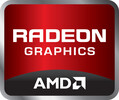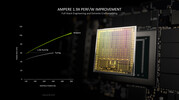AMD Radeon HD 6950M vs NVIDIA GeForce RTX 3070 Max-Q
AMD Radeon HD 6950M
► remove from comparison
The AMD Mobility Radeon HD 6950M (or sometimes called ATI Mobility Radeon HD 6950) is a high-end graphics card generally used for big and heavy laptops. It is based on the desktop HD 6850 graphics card and therefore features the new UVD3 video processor, increased Tessellation performance and Eyefinity+. The codename of this GPU is Blackcomb Pro and it should have similar power consumption as the GeForce GTX 470M. Compared to the faster HD 6970M, the 6950M's core is clocked slower by at least 100 MHz.
The 960 Stream processors should be still based on the "old" 5D architecture, similar to the 5000 series. Therefore, the number of shaders in the 6950M is not comparable to the 1D cores of current Nvidia GPUs. The Tessellation performance, however, should be improved (like the desktop 6800 series) with the new cards. The Stream processors can be used with DirectX 11, OpenGL 4.1, DirectCompute 11 and OpenCL. With the latter two, the cores of the 6950M can also be used for general computations like video transcoding.
The 3D performance is on par with the GeForce GTX 470M in the high end class of notebook graphic cards. For gamers, this means that the Radeon HD 6950M is able to fluently play most modern games (as of 2011) in high detail settings. Only Crysis and Metro 2033 will stutter in the highest detail settings at 1920x1080 resolution (see below).
The new UVD3 video decoder supports the decoding of MPEG-4 AVC/H.264, VC-1, MPEG-2, Flash and now also Multi-View Codec (MVC) and MPEG-4 part 2 (DivX, xVid) HD videos on the graphics card.
Furthermore, the HD 6900M series integrates an HD audio controller to transmit HD Audio (TrueHD or DTS Master Audio) over HDMI and DisplayPort (e.g., for Blu-Ray videos).
The AMD HD3D Technology offers support for Blu-Ray 3D and 3D displays (integrated and external). However, the solution is not as mature as Nvidia's 3D Vision.
Thanks to Eyefinity, the graphics chip is able to theoretically drive up to 6 monitors simultaneously provided that the notebook itself has enough video-out ports.
The power consumption of the 6950M should be similar to the Nvidia GeForce GTX470M and is therefore only suited for medium to large laptops with good cooling solutions.
NVIDIA GeForce RTX 3070 Max-Q
► remove from comparison
The Nvidia GeForce RTX 3070 Max-Q (for laptops, GN20-E5 Max-Q) is the former name for a RTX 3070 Laptop GPU with Max-Q technologies. In previous generations, the Max-Q name was used for low power versions. With the RTX 3000 series, every TGP-version can now use Max-Q technologies and all GPUs are called RTX 3070 Laptop GPU (80 - 125W).
| AMD Radeon HD 6950M | NVIDIA GeForce RTX 3070 Max-Q | |||||||||||||||||||||||||||||||||||||||||||||||||||||||||||||||||||||||||||||||
| GeForce RTX 3000 Series |
|
| ||||||||||||||||||||||||||||||||||||||||||||||||||||||||||||||||||||||||||||||
| Codename | Blackcomb Pro | GN20-E5 GA104 | ||||||||||||||||||||||||||||||||||||||||||||||||||||||||||||||||||||||||||||||
| Architecture | Terascale 2 | Ampere | ||||||||||||||||||||||||||||||||||||||||||||||||||||||||||||||||||||||||||||||
| Pipelines | 960 - unified | 5120 - unified | ||||||||||||||||||||||||||||||||||||||||||||||||||||||||||||||||||||||||||||||
| Core Speed | 580 MHz | 1290 (Boost) MHz | ||||||||||||||||||||||||||||||||||||||||||||||||||||||||||||||||||||||||||||||
| Memory Speed | 900 MHz | |||||||||||||||||||||||||||||||||||||||||||||||||||||||||||||||||||||||||||||||
| Memory Bus Width | 256 Bit | 256 Bit | ||||||||||||||||||||||||||||||||||||||||||||||||||||||||||||||||||||||||||||||
| Memory Type | GDDR5 | GDDR6 | ||||||||||||||||||||||||||||||||||||||||||||||||||||||||||||||||||||||||||||||
| Max. Amount of Memory | 2048 MB | 8 GB | ||||||||||||||||||||||||||||||||||||||||||||||||||||||||||||||||||||||||||||||
| Shared Memory | no | no | ||||||||||||||||||||||||||||||||||||||||||||||||||||||||||||||||||||||||||||||
| API | DirectX 11, Shader 5.0 | DirectX 12_2, Shader 6.7, OpenGL 4.6 | ||||||||||||||||||||||||||||||||||||||||||||||||||||||||||||||||||||||||||||||
| Transistors | 1.7 Billion | |||||||||||||||||||||||||||||||||||||||||||||||||||||||||||||||||||||||||||||||
| technology | 40 nm | 8 nm | ||||||||||||||||||||||||||||||||||||||||||||||||||||||||||||||||||||||||||||||
| Notebook Size | large | large | ||||||||||||||||||||||||||||||||||||||||||||||||||||||||||||||||||||||||||||||
| Date of Announcement | 06.01.2011 | 04.01.2021 | ||||||||||||||||||||||||||||||||||||||||||||||||||||||||||||||||||||||||||||||
| Link to Manufacturer Page | www.amd.com | |||||||||||||||||||||||||||||||||||||||||||||||||||||||||||||||||||||||||||||||
| Power Consumption | 80 Watt |


 Deutsch
Deutsch English
English Español
Español Français
Français Italiano
Italiano Nederlands
Nederlands Polski
Polski Português
Português Русский
Русский Türkçe
Türkçe Svenska
Svenska Chinese
Chinese Magyar
Magyar